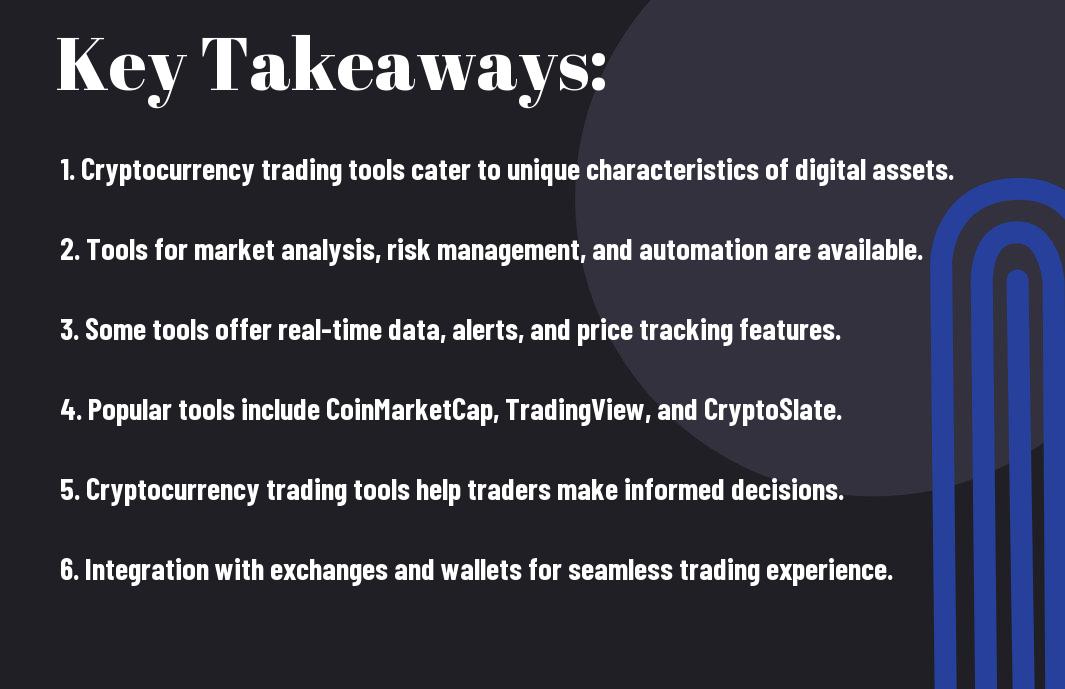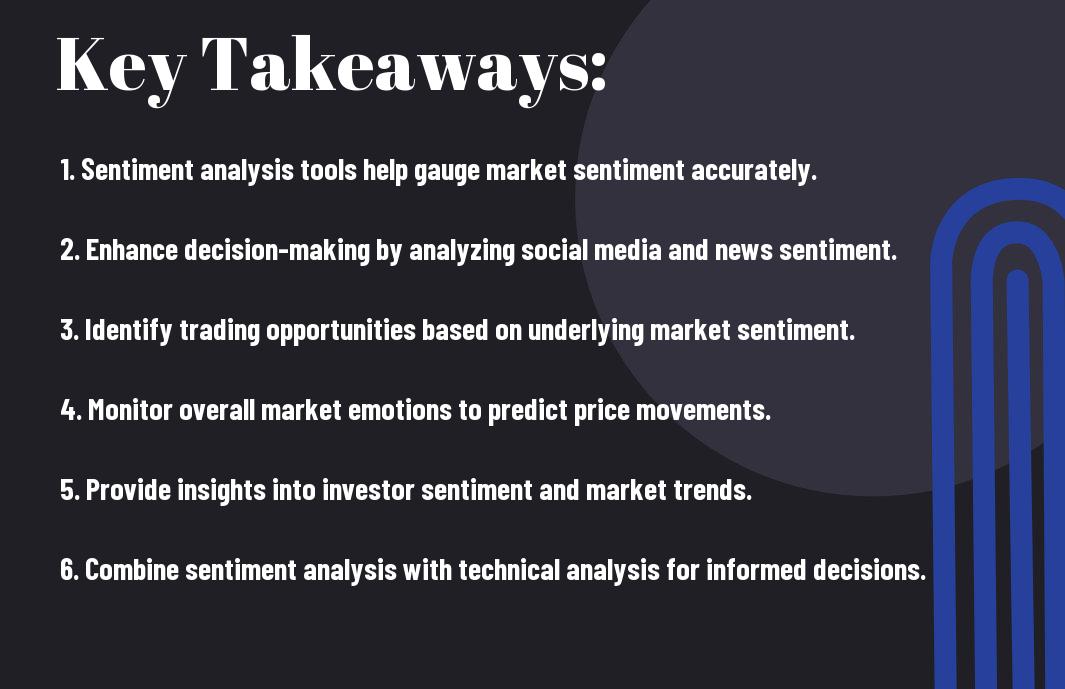Cryptocurrency trading can be complex, but with the right tools, you can navigate the market more effectively. In the world of digital assets, there are specialized trading tools designed specifically for cryptocurrency trading. These tools offer unique features tailored to the fast-paced and volatile nature of the crypto market, providing you with the insights and analysis you need to make informed trading decisions. Whether you are a seasoned trader or just starting out, incorporating these specialized tools into your trading strategy can give you a competitive edge in the cryptocurrency market.
Key Takeaways:
- Cryptocurrency trading tools: There are market trading tools specifically designed for cryptocurrency trading that can help traders analyze market trends, execute trades, and manage their portfolios.
- Features: These tools may offer features such as real-time price tracking, technical analysis indicators, trading bots, portfolio management, and risk management tools.
- Popular tools: Some popular cryptocurrency trading tools include TradingView, Coinigy, and Binance. It’s important for traders to research and choose the tools that best suit their trading strategy and goals.
The Unique Challenges of Cryptocurrency Trading
Volatility and Market Fluctuations
For cryptocurrency traders, one of the biggest challenges you will face is the extreme volatility and market fluctuations that are inherent in this space. Cryptocurrencies are known for their erratic price movements, with values often skyrocketing or plummeting within a short period. This volatility can make it difficult to predict market trends accurately, increasing the risk associated with trading cryptocurrencies.
Regulatory Uncertainty and Security Concerns
Concerns about regulatory uncertainty and security risks are prevalent in the world of cryptocurrency trading. The lack of clear regulations governing the trading of digital assets in many countries can lead to legal complications and ambiguities. Additionally, the risk of cyberattacks and theft is a significant concern for cryptocurrency traders, as digital assets are susceptible to hacking and fraud.
It’s necessary to stay informed about the latest regulatory developments and security measures to protect your investments in the volatile world of cryptocurrency trading. Implementing robust security practices, such as using secure wallets and two-factor authentication, can help mitigate the risks associated with trading digital assets.

Traditional Trading Tools and Their Limitations
Some traditional trading tools used in the financial markets are technical analysis and charting tools. These tools help traders analyze historical price movements and volume data to identify patterns and trends in the market. However, their usefulness in cryptocurrency trading is limited due to the high volatility and relatively young age of the market. Cryptocurrency prices can be influenced by a wide range of factors, making it challenging to rely solely on historical data for making trading decisions.
Technical Analysis and Charting Tools
The use of technical analysis and charting tools in cryptocurrency trading can be helpful in identifying potential entry and exit points based on historical price patterns. However, the rapid price fluctuations and lack of regulation in the cryptocurrency market can render traditional technical analysis less effective. You may find that some tools designed for traditional markets may not work as well when applied to cryptocurrencies.
Fundamental Analysis and News-Based Tools
For fundamental analysis and news-based tools, it’s imperative to keep in mind that the cryptocurrency market is highly influenced by news events and regulatory developments. Factors such as government policies, technological advancements, and market sentiment can all have a significant impact on cryptocurrency prices. Therefore, staying updated with the latest news and developments in the cryptocurrency space is crucial for making informed trading decisions.
This means that you should not only rely on historical price data but also pay close attention to news sources and events that could affect the market. By incorporating fundamental analysis and news-based tools into your trading strategy, you can better navigate the volatile cryptocurrency market and make more informed decisions.

The Emergence of Cryptocurrency-Specific Trading Tools
Blockchain Analytics and On-Chain Data
For cryptocurrency traders, having access to accurate and timely data is crucial for making informed trading decisions. This is where blockchain analytics and on-chain data tools come into play. These tools specialize in tracking transactions on the blockchain and providing valuable insights into market dynamics. By analyzing on-chain data, such as transaction volume, wallet activity, and network fees, you can gain a better understanding of market trends and investor behavior.
Social Media and Sentiment Analysis Tools
Blockchain technology has given rise to a new breed of trading tools that focus on social media and sentiment analysis. These tools scour social media platforms, forums, and news sites to gauge market sentiment and trends. By monitoring discussions and analyzing the sentiment of market participants, these tools can provide valuable insights into market psychology and potential price movements. Incorporating sentiment analysis into your trading strategy can help you stay ahead of the curve and make more informed decisions.
It is fascinating to see how social media and sentiment analysis tools have revolutionized the way cryptocurrency traders approach the market. By leveraging the power of big data and machine learning algorithms, these tools can process vast amounts of information in real-time, giving you a competitive edge in the fast-paced world of cryptocurrency trading.
Advanced Trading Tools for Cryptocurrency
Your journey into cryptocurrency trading can be greatly enhanced by utilizing advanced trading tools. These tools are specifically designed to help you navigate the volatile and fast-paced world of digital assets. To stay ahead of the curve, it’s crucial to leverage the latest technologies and strategies available to crypto traders. Below are some crucial tools that can elevate your trading game:
- Must-Have Trading Tools for Crypto Traders –
Tool Description Machine Learning and AI-Powered Trading Bots Automate your trades, analyze market data, and make informed decisions with the help of sophisticated algorithms. High-Frequency Trading and Scalping Tools Execute trades at lightning speed and capitalize on small price differentials in the market for quick profits. Machine Learning and AI-Powered Trading Bots
Bots have revolutionized cryptocurrency trading by allowing you to automate your trading strategies and execute trades with precision. Machine learning and AI-powered bots can analyze vast amounts of data in real-time, identify patterns, and make split-second decisions to maximize your profits. By leveraging these advanced tools, you can stay ahead of the market trends and capitalize on opportunities that may otherwise go unnoticed.
High-Frequency Trading and Scalping Tools
Any serious cryptocurrency trader knows the importance of high-frequency trading and scalping tools. These tools are designed to help you execute trades at ultra-fast speeds, taking advantage of small price movements in the market. By engaging in high-frequency trading and scalping, you can potentially generate profits on a more frequent basis, capitalizing on even the smallest fluctuations in asset prices. Mastering these tools can give you a competitive edge in the fast-paced world of crypto trading.
Advanced trading tools for cryptocurrency are crucial for staying competitive in the fast-evolving digital asset market. By leveraging machine learning and AI-powered trading bots, as well as high-frequency trading and scalping tools, you can enhance your trading strategies and maximize your profitability. These tools enable you to make data-driven decisions, automate repetitive tasks, and execute trades with precision, ultimately helping you navigate the complexities of cryptocurrency trading successfully.
Risk Management and Portfolio Optimization Tools
Despite the volatility in the cryptocurrency market, you can mitigate risks and optimize your trading portfolio with various tools available. To enhance your trading experience, it is crucial to employ risk management strategies and utilize portfolio optimization tools. For a comprehensive guide on the best tools for crypto trading analysis and research, you can refer to Best Tools for Crypto Trading, Analysis and Research.
Stop-Loss and Position Sizing Strategies
Optimization of your trading portfolio involves implementing stop-loss orders to cap potential losses and position sizing strategies to determine the appropriate amount to invest in each trade. By setting stop-loss orders at predetermined price levels, you protect your investment from significant downturns. Position sizing strategies help you allocate the right proportion of your capital to individual trades, ensuring that no single trade significantly impacts your overall portfolio.
Diversification and Asset Allocation Techniques
Risk management in cryptocurrency trading also involves diversification and asset allocation techniques. By diversifying your portfolio across different cryptocurrencies and asset classes, you spread risk and reduce exposure to market fluctuations. Asset allocation involves distributing your investment capital among various assets based on factors such as risk tolerance, investment goals, and market conditions.

The Role of Exchanges and Brokerages in Cryptocurrency Trading
Not only do cryptocurrency exchanges and brokerages provide a platform for you to buy and sell digital assets, but they also offer a range of trading tools and features to enhance your trading experience.
Exchange-Traded Funds (ETFs) and Futures Contracts
Cryptocurrency exchange platforms often offer Exchange-Traded Funds (ETFs) and Futures Contracts, allowing you to trade on the price movements of digital assets without actually owning them. These financial instruments can provide you with additional flexibility in your trading strategy and allow you to diversify your investment portfolio in the crypto market.
Margin Trading and Leverage Options
Options for margin trading and leverage are commonly available on cryptocurrency exchanges. This feature allows you to amplify your trading position by borrowing funds from the exchange. While margin trading can increase your potential profits, it also comes with higher risks, as losses can exceed your initial investment. It is necessary to understand how leverage works and to use it cautiously in your trading activities.
Another important aspect to consider when engaging in margin trading and leverage options is the concept of liquidation. If the value of your position falls below a certain threshold, the exchange may liquidate your assets to cover the borrowed funds. Thus, it is crucial to monitor your positions closely and set appropriate risk management strategies to protect your investments.
Summing up
Following this exploration of market trading tools, you now understand that there are indeed specific tools designed for cryptocurrency trading. These tools range from charting platforms like TradingView and Coinigy to automated trading bots like 3Commas and Cryptohopper. By utilizing these tools, you can enhance your cryptocurrency trading experience, improve your analysis, and potentially increase your profits.
Bear in mind, when selecting trading tools, it is necessary to consider factors such as your trading style, experience level, and budget. By incorporating these tailored tools into your trading strategy, you can navigate the dynamic world of cryptocurrency markets more effectively and make informed trading decisions.
Q: Are there market trading tools specifically designed for cryptocurrency trading?
A: Yes, there are several market trading tools that are specifically designed for cryptocurrency trading. These tools often provide features such as real-time market data, advanced charting tools, trading signals, portfolio management, and automated trading strategies tailored for the unique characteristics of the cryptocurrency markets.
Q: What are some popular market trading tools for cryptocurrency trading?
A: Some popular market trading tools for cryptocurrency trading include Coinigy, TradingView, Cryptohopper, 3Commas, and CoinMarketCap. These tools offer a wide range of functionalities to help traders analyze market trends, execute trades, and manage their cryptocurrency portfolios effectively.
Q: How can market trading tools help cryptocurrency traders improve their trading strategies?
A: Market trading tools can help cryptocurrency traders improve their trading strategies by providing them with valuable insights into market trends, price movements, and trading patterns. These tools can help traders make informed decisions, set up risk management parameters, and automate trading processes to take advantage of potential opportunities in the highly volatile cryptocurrency markets.




